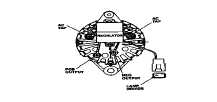| |
TM 10-3930-671-24
45 Amp System with Regulator
FIGURE NO. 5.1
The lamp driver function works off AC taps. The lamp
turns off at a voltage > 9 volts. When AC tap potential
drops below 6 volts the lamp turns back on (FIGURE
NO. 5.2).
When the ignition switch is "on" and the alternator is not
spinning, the indicator lamp will be "on". With the
alternator
spinning,
the
regulator
turns
Non"
at
approximately 800-1000 RPM (rotor RPM) and AC
voltage generated in stator windings is amplified by the
turn-on circuit in voltage regulator. Once this point is
reached, the power transistor is turned "on", allowing the
rotor to be magnetized (Full Field). When this condition
is reached, the alternator starts to charge (Rotor speed
reaches approximately 1700 RPM). The lamp will turn
"off" when a voltage at the AC Tap is > to 9 volts. System
voltage is at 14.3 + .2 volts.
FIGURE NO. 5.2
ZENER DIODE - The Zener diode is a rather unique
diode; the ability to pass current in the forward bias mode
of
the
Zener
diode
is
similar
to
the
"normal"
characteristics of an ordinary diode. However, in the
reverse bias direction, the Zener diode has the ability at
a predetermined voltage to literally "destroy" its’ high
reverse bias characteristic, thus allowing current to flow
through it.
FIGURE NO. 6
The above may be seen more clearly by observing
Figure No. 6. Figure No. 6 shows the typical operating
characteristics of a 1 O0V Zener diode. This can be
seen when starting at the zero bias point and moving to
the right, or in to the forward bias area. Almost
immediately, the diode allows current to flow, identical to
the operational characteristic of a "normal" diode. Now,
F-273
|





